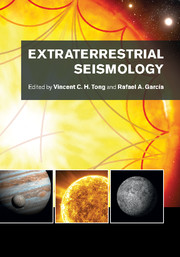Book contents
- Frontmatter
- Contents
- List of contributors
- Preface
- Acknowledgements
- List of abbreviations
- Planetary seismology: High risk, high return
- A bright outlook for helio- and asteroseismology
- Part I Observation and space missions
- Part II Data and physical parameters
- Part III Modeling approaches
- Part IV Discoveries of physical structures and processes
- Part V Interdisciplinary research involving planetary and astrophysical sciences
- 16 Diskoseismology of accretion disks
- 17 Numerical simulations of magnetoconvection and helioseismology
- 18 Impact seismology on terrestrial and giant planets
- 19 Angular momentum transport in stars: From short to long time scales
- 20 From the Sun to the distant stars, and back: Future research directions
- 21 Stellar dynamics: Rotation, convection, and magnetic fields
- 22 Sunquakes: Helioseismic response to solar flares
- 23 Seismic waves in small bodies: Sources and propagation
- Part VI Interdisciplinary research involving terrestrial seismology
- References
- Index
19 - Angular momentum transport in stars: From short to long time scales
from Part V - Interdisciplinary research involving planetary and astrophysical sciences
Published online by Cambridge University Press: 05 July 2015
- Frontmatter
- Contents
- List of contributors
- Preface
- Acknowledgements
- List of abbreviations
- Planetary seismology: High risk, high return
- A bright outlook for helio- and asteroseismology
- Part I Observation and space missions
- Part II Data and physical parameters
- Part III Modeling approaches
- Part IV Discoveries of physical structures and processes
- Part V Interdisciplinary research involving planetary and astrophysical sciences
- 16 Diskoseismology of accretion disks
- 17 Numerical simulations of magnetoconvection and helioseismology
- 18 Impact seismology on terrestrial and giant planets
- 19 Angular momentum transport in stars: From short to long time scales
- 20 From the Sun to the distant stars, and back: Future research directions
- 21 Stellar dynamics: Rotation, convection, and magnetic fields
- 22 Sunquakes: Helioseismic response to solar flares
- 23 Seismic waves in small bodies: Sources and propagation
- Part VI Interdisciplinary research involving terrestrial seismology
- References
- Index
Summary
In this chapter we briefly summarize how angular momentum is being transported and exchanged between convective and radiative zones in stars. We discuss what physical processes influence the internal rotation history of stars on short to long (secular) time scales.
The astrophysical context
Stars are rotating magnetic bodies with complex internal and external dynamics. Observations using helioseismology (e.g., García et al., 2007), asteroseismology (e.g., Deheuvels et al., 2014), and spectropolarimetry (e.g., Donati and Land street, 2009) techniques put more and more constraints on this intricate dynamics. To get a complete and coherent picture of dynamical processes in stars and of the associated transport of angular momentum that goes beyond the “standard” modeling of stellar structure and evolution (Maeder, 2009) one needs to develop new models by introducing an improved physical description of these time-dependent processes. However, to simulate such processes in a star in full detail requires treating spatial and temporal scales spanning about 10 orders of magnitude. This is clearly not yet feasible, even with the most powerful computers available today. Therefore, one can choose to describe what occurs on a dynamical time scale (such as a convective turnover time or stellar magnetic cycles) or on the long-term evolution where the typical characteristic time scale is the dominant nuclear reactions. The same applies for spatial scales. One has to choose which relevant scale one needs to model in order to accurately describe the spatial dependence of the physical processes (convection motions, MHD instabilities, transport and mixing processes, surface dynamics).This is the reason why it is nowadays necessary to use and couple 1D, 2D, and 3D models to get a global picture of macroscopic MHD transport processes in stars over short to secular time scales.
In this chapter, we report on the state of the art of the modeling of the transport of angular momentum in stars both in convection and in radiation zones and we present our main contributions to this field of research.
- Type
- Chapter
- Information
- Extraterrestrial Seismology , pp. 264 - 275Publisher: Cambridge University PressPrint publication year: 2015
- 2
- Cited by



